“The beauty of winter is its mystical aura,” writes snowshoe philanthropist and health authority Dr. Jeff Kildahl (JK). “Winter acutely defines one’s perspective. Snow represents a white blanket of desolation or bliss. The frigid temperatures and deafening silence of winter can both heighten awareness and stifle creativity amid its dank presence.”
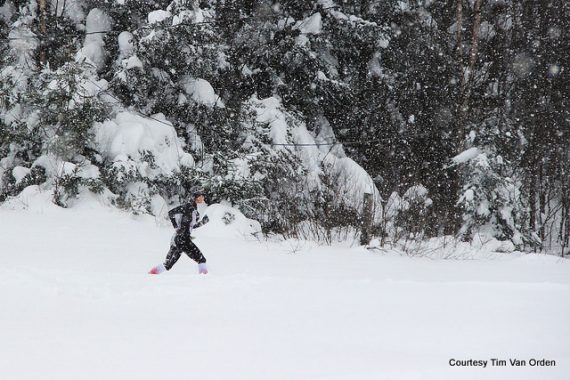
Racing the 2018 USSSA National Championships, VT, Jamie Woolsey makes way
A major key to achieving grand goals in a long distance snowshoe contest necessitates imitating what successful athletes do. Around the corner from the will-to-win, one discovers their hidden secret . . . The will to prepare to win. Where to begin that preparation? Right here:
Preparing to Win Part 1: Dress The Part
Christine Blanchette (CB), named Running Television Celebrity by Vancouver’s Daily Hive, provides these answers: Ready. Set. Snowshoe!
Snowshoeing is a sport or activity that is not only fun for all levels of abilities, but it offers a great cardio workout. For runners, it is a good cross training option. If you are a recreational or elite snowshoer, the most important equipment is investing in a pair of snowshoes for your performance goal.
In my case as a runner, I chose a pair of Atlas racing snowshoes as they are light because they are made with aluminum. For gear, I simply wear running clothes and include gloves and a hat. I prefer trail shoes with Gore-Tex to wear with my snowshoes; however, using road running shoes are okay.
Dress For Success Tips From Elite Snowshoers
In addition to my own experience, I interviewed two elite women snowshoers who shared their preparation tips. Emily Renner, from Boulder Country, Colorado, races in Atlas race snowshoes as well. Emily agrees, “These are very lightweight shoes with little drag. For training, I either use either Atlas Elektra Treeline or Race depending on trail conditions and the workout planned.”
For her equipment and gear, Emily says, “My go-to outfit for training and racing: Many (usually three) layers of tall wool socks, race tights with a very thin waterproof top layer, thick waterproof mittens, light long sleeve with waterproof vest, and a stocking cap.”

Always training! Emily Renner on her snowshoes
She adds, “The thing I struggle with the most in snowshoe running is not the race itself, it’s becoming cold. It’s hard to find a balance between overdressing to the point of sweating and becoming chilled, versus completely underdressing.
Last year’s USSSA National Championships was in Bennington, VT, and they had 52 inches of snow 48 hours before the race! We were practically swimming in snow through the course, and staying dry and warm was critical to a successful race.”
Dressing in layers is the key to staying warm, which is the same as running on the road or trail. Check for weather conditions before heading out and bring an extra change of clothes with you including socks and shoes to change later.
Annie Jean from Chelsea, Quebec, enjoys snowshoeing in the Eastern Townships in Quebec as well as cycling. She races in TSL Hyper-Flex snowshoes. She claims it doesn’t collect clumps or balls of snow underneath. Annie says. “Go out and try snowshoeing before racing. Always dress lighter. It is okay to feel colder at the beginning.” Annie likes to wear earmuffs to keep her ears warm, in addition to wool socks, and for night racing she wears a headlamp.
Annie points out, “It is harder to do 20 km (on snow) than running 20 km on the road. Every course is different.”
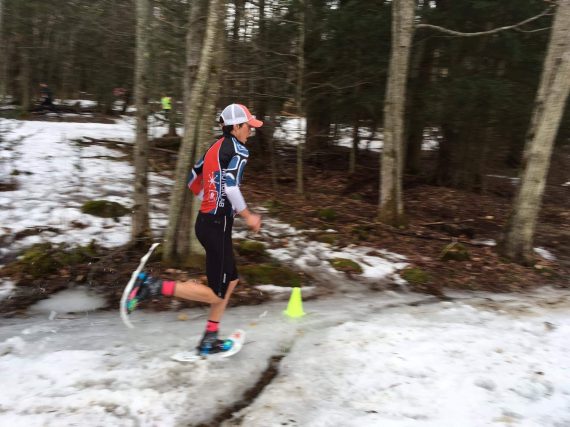
Annie Jean races all snow conditions
Preparing To Win Part 2: Build Endurance
The following tips provided by Dr. Jeff Kildahl
August flares an insatiable itch for snowshoeing. Hill repeats and related training sessions with snowshoes in triple-digit heat on sand become bad company and are no longer welcomed. The emergence of cool, crisp mountain air becomes intuitive.
My relentless Scandinavian spirit welcomes the opportunity to test my coping in extreme conditions. My lineage may even provide an unfair advantage when confronted with Mother Nature’s irreverence.
The reliance I have on exceptional apparel, fuel, gear, and accessories during solo, unsupported ultra-endurance endeavors with a charitable component is unequivocal. Arduous journeys thanks to cutting-edge, sustainable products and preparation manifest inexpressible transpersonal lessons and gratitude.
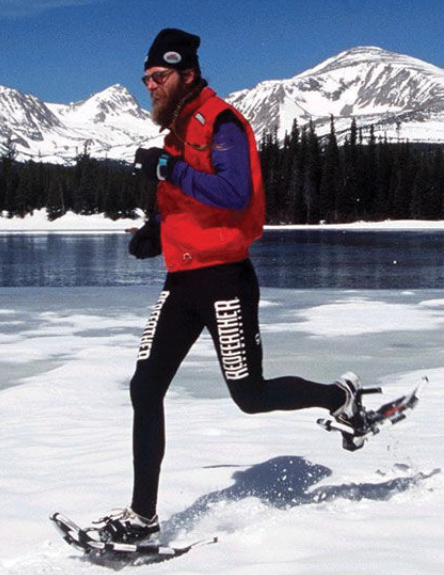
A snowshoe pioneer, Tom Sobal excels in long-distance events including the 100-mile benchmark
Snowshoe racing is an indescribable experience. Solo ultra-endurance-sports philanthropy is a unique cat yielding profound impact under the radar. Whether you are attempting via snowshoes your first marathon, a cause marketing gig, or doubling a winter ultra 150-mile race (like Roberto Marron), there are a few secrets to mitigating the pain. Here are some:
Will To Keep Going
Endurance is often associated with stamina and suffering. The will to take another step and endure hardship on the precipice of disaster represents both noble and humbling experiences. Conditions impact breath, posture, knee lift, and fueling options. When you understand your endeavor, it becomes primarily a mental test, and often times the ever-present pain will retreat.
Adjust Your Step
Snowshoeing requires an adjustment of our gait. Many athletes erroneously impart long tail to tip strides when short, compact steps are more efficient in the spirit of muscle economy. The key to snowshoeing proficiency is to remember that arm swing propels your legs and regulates cadence. Think stride rate versus stride length. This principle enhances or hinders the critical element known as flotation.
Take Care of Your Ankles and Feet
Prior to hitting fresh powder, it would be prudent to give your feet and ankles some love. One bout of contused capillaries or feeling the warmth of blood flow in your gaiters will change your mind. Coach Steve Ilg apprised me decades ago about a surefire approach to mitigate the foregoing:
- Ankle taping to protect your precious ankles and stabilize gait. Pay particular attention to the navicular region;
- Toe socks to mitigate chafing, blisters, and hot spots thanks to its fabric and seamless construction;
- Frictionless and seamless cycling socks;
- Neoprene seamless socks for flexibility and warmth. Keep neoprene in mind for your hands, head, and face.
Fuel Your Body
Snowshoe racing is more difficult from a biomechanical perspective than its complementary gem trail running. The constant for both sports: food is fuel. The metabolic keys remain digestion, absorption, and assimilation. Primary source foods represent the unequivocal path to optimal health and performance in life and sport.
The foremost nutrition limiter to endurance sport performance is depleted glycogen stores. Reliance by many athletes on carbohydrate as their primary fuel source remains pervasive and indefensible because it sabotages one’s potential.
The key to peak performance is Metabolic Efficiency™. This concept manifests sport performance excellence because of your diet, not in spite of it. A by-product of Metabolic Efficiency™ is its innumerable benefits respective to health markers. Metabolic Efficiency™ is the body’s ability to utilize its endogenous stores of carbohydrate and fat at varying intensities and duration of exertion and rest. This becomes critical training for and during the marathon distance at the USSSA Championships. Dragging a pulk for 48-hours in the snow also validates this principle.
The body shifts its primary fuel source from fat to carbohydrate as intensity levels increase. This shift is an ineffective route to optimal health and sport performance. Most commercial sports drinks are composed of simple sugars [sucrose or fructose] or maltodextrin creating both quick energy and an unhealthy cycle of blood sugar spikes and crashes.

“Plant Powered Anna” shows the benefits of her lifestyle
The desired outcome is to preserve glycogen until it is needed at maximum intensity. Insulin sensitivity is paramount to this process, and it is attainable only via Metabolic Efficiency™. Fat adaptation is the key. Insulin resistance significantly impairs health and performance.
The backlash from making artificial colors and flavors, refined sugar, and other [acidic] processed ingredients palatable is poor health and performance due to nutritional stress. Insulin-stimulating carbohydrate represents an insidious path to the podium of self-destruction.
Fat adaption allows less re-fueling which means less to carry and enhances the principles of sport nutrition:
- Nutrient density;
- Nutrient timing;
- Speed of recovery
Mentally Preparing for the Start
Okay, now you line up behind the startline of any race. Positive self-assurances may help, but unless they’re backed by the tough work to make it all happen, well, it won’t get you where you want to go. The outcome won’t be what’s in your mind. Wishing and hoping fall prey to bonking and retching.
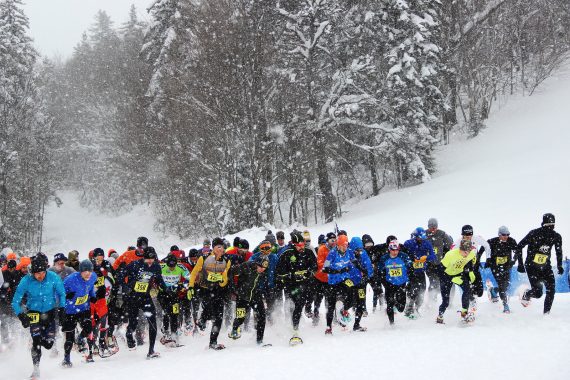
A start in a snowshoe race while it’s snowing . . . it is the best!
Dr. Michael Joyner, with a long residency at the Mayo Clinic, Rochester, MN, published more than 25 years ago the wild notion that road marathon times could drop below two hours. Now athletes, in a nod to Bob Dylan, are “knock, knock, knocking” loudly on that door. In an interview published in the Autumn 2018 Star Tribune Magazine, he advises:
“I think what you learn from elite athletes is to be a maximalist but you first have to be a minimalist. What these folks are really good at is getting rid of distractions and identifying what’s important and focusing on it.” (pg 39)
Christine Blanchette notes that Emily Renner focuses on the art of visualization: “I believe visualization and mental preparation are very important in both snowshoe and road racing. In order to be truly prepared for a big event, I spend a few minutes each day leading up to a race, going over my race day plan and visualizing myself achieving my goals. Visualization includes everything from mentally preparing to be uncomfortable to achieving the goals I have trained so hard for,” she says.

Sarah Canney, the RunFarGirl, demonstrates a new twist of training on a beach
Trail Time Fun: Not Only On Snowshoes
To achieve distances of a half-marathon, marathon or an ultra length like 100 km demands mental toughness distilled from a mythical potent called TOT or time-on-trail. In a type of emotional mysticism one begins to befriend effort’s pain, or as James Hetfield screams on a Metallica stage, embraces “My Friend of Misery.”
You call this sport? Well, yes. There are athletes right now training to make a goal out much further than this month, and with more meaning than just another trip you’re making to the refrigerator. Let Mr. Hetfield sing it in your head: “One man’s fun is another’s hell.“
Emily explains in her interview with Christine Blanchette, “Snowshoe training is unique in that most of the training is not done in snowshoes. Once there is finally snow in the high country, I will snowshoe run once or twice a week along a mountain trail. These runs are much slower than normal runs and involve spurts of power hiking when my legs become fatigued. Snowshoe running is hard work. The majority of my training for snowshoe racing is very similar to road and trail races: lots of easy recovery runs with some speedwork mixed in.
In addition to running, I have found spinning to be very helpful. Cranking up the resistance mimics the weight of snowshoes perfectly without adding extra stress to your legs. Remember, snowshoe racing is fun. The uphills are a consistent burn, but then you are rewarded by being able to go all out on the downhills. The worst thing that will happen is you find yourself stuck in a nice, soft snowbank. The people at snowshoe races are also some of the kindest folks you will meet. Everyone is looking for an excuse to get outside and enjoy nature on a cold day.”
Christine finds “Working out on the elliptical is helpful as well as simply mimicking what I do for training for road racing such as fartlek, long runs, and tempo workouts.
“Winter is Mother Nature’s way of saying ‘Up Yours.’” – Robert Byrne
You have an internal friend prescribing a legal drug allowing you to accommodate a physical overload, that hellish feeling. The endorphin elixir races to activate the body’s opiate receptors. You don’t become Pink Floyd’s “Comfortably Numb,” but rather a wholesomeness and sense of purpose flood your thoughts, which leads one to appreciate the contribution of my pal Misery.
Racing is a job for many athletes like Joseph Gray of Colorado Springs, CO, a Hoka One professional. He gallops in their Evo Jawz trail shoes, which he describes as providing “an exhilarating and unbridled ride.” Gray admits the training aspect unleashes his inner Curious George whose characteristics include learning and playful curiosity. “I’ll see a trail and wonder where that goes.” Just taking off on it “gives me peace.”
His training work provides fun. 16 national titles such as the World Snowshoe Federation’s 2017 Championships and 2018 North American Snowshoe Championships along with five consecutive North American Central American Mountain Running titles proves his ability. His charisma comes from the enjoyment of it all.

Joseph Gray celebrates his 2017 World Snowshoe Federation win and a new title: World Champion!
Train hard, recover hard; give your physique a rest. You’ll accomplish so much more by doing so. And training right up to the start gun? Don’t do it. As my cross-country ski friend, Steve Shelerud says, the hay is already in the barn, meaning your training is done days before the race. Save your legs and your energy for the upcoming challenge. One can prepare and edit a speech right up to standing at the podium, but it isn’t the same with utilizing physical requirements to go a distance.
The Race: Have A Strategy
The horn blows, the start is underway. You take off. It’s crowded, there’s some jostling, and someone comes up from behind and around you while the person next to you moves forward a little quicker, too. So what should we do? Move faster, of course. This is a race and you gotta stay ahead, or at least that’s what our untrained brain says.
Dr. Joyner reports in a paper he co-authored (a study of 100,000 marathon finishes) the revelation that going out too fast in a distance race, and it’s mostly men, causes one to “buy the farm or explode” in the latter half of the required miles. In other words, have a workable strategy for your goals, remind yourself of them as you take those initial steps, and though you may alter them on-the-run, at least you have a roadmap, a plan to achieve your target.

5X USSSA Men’s National Champion Eric Hartmark races as a great Ambassador for the sport
Through training, testing your equipment, and entering races as checkups of your condition, needed improvements or steps to your key goal emerge like a dawning sun. And maybe, just maybe you can achieve what Dr. Joyner reports elite athletes (or elite in anything) understand: how to simultaneously relax while exerting maximal effort.
Take an example from outside the world of mountains and trails; watch Louis Lortie a top pianist alive today as he interprets Chopin Etudes. He didn’t just wake up on a Saturday morning and play like this. He trains just like we do though in a different sport employing 88 keys. And you think running takes guts. Like he says, “(Piano) takes a lot of energy out of you.”
Not everyone races to win the overall gold medal, as such ranks as an unrealistic objective. One can work for other targets like an age-class medal or rank in the top 10 of the 50 in your class. In my world, a silver or bronze age-class medal, particularly in a national event, wears like gold.
Recovery

After 150 Tuscobia miles: Candel and Sandor lay it out.
A key to recovery: get out of those race clothes and into warm, dry clothes as quickly as possible after crossing the finish line. Have the gear bagged and ready in the race headquarters. For those who use post-race recovery foods or drinks, have them ready to go and packed before you ever start the race.
Dr. Jeff Kildahl recommends, physiological assessments and dietary shifts are required to become fat adapted (a key to recovery). Metabolic Efficiency™ is a 75% nutrition and 25% exercise intervention. One product on the market provides sustained natural energy levels absent of repetitive insulin spikes and crashes. It is a revolutionary proprietary fuel source because of its unique molecular weight, low osmolality, and slow absorption characteristics branded as SuperStarch by Generation UCAN®.
Find below a few scientifically validated health and performance benefits of being fat adapted:
- No GI distress;
- Improves nutrient partitioning;
- Body composition and weight improves;
- Improves health markers and risks associated with chronic and degenerative diseases;
- Optimized performance;
- Maximized glucagon secretion;
- Sustained energy;
- Enhanced lipolysis and fat oxidation;
- Reduced cravings;
- Swift recovery.
Endurance athletes require precision nutrition. Food is sacred. Nutrition plays a profound role in every phase of your life. No amount of training, gear, apparel, accessories, or podium finishes can inhibit the insidious mayhem of dietary neglect. Your health and sport performance are inside-out propositions.
WHAT’S ON THE RACE SCHEDULE
Emily Jenner will be a member of the team representing the United States at the World Snowshoe Federation Championships, Italy, January 5, 2019. She will also focus on local Colorado races including the Beaver Creek Snowshoe Race Series and Eldora Nighthawks
Annie Jean explained, “What is next for me is I am recovering and rebuilding now and not racing”
Joseph Gray will be a member of the team representing the United States at the World Snowshoe Federation Championships in 2019
Christine Blanchette is racing the 35th classic Vancouver cross-country challenge Gunner Shaw on December 1, 2018
Dr. Jeff Kildahl is racing the United States Snowshoe Championships, March 8-10, 2019
Eric Hartmark is racing the USSSA National Championships and other events
Phillip Gary Smith finished the Surf the Murph 34-mile trail ultra, racing the Mendota Trail 5K snowshoe/run Dec 9, and the USSSA Championship Marathon March 8-10, 2019.
FOLLOW ON TWITTER:
Phillip Gary Smith plus UltraSuperior and The Eclectic 18


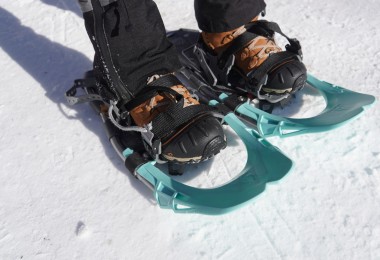
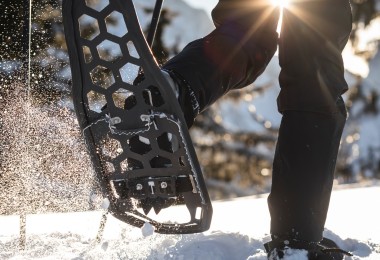
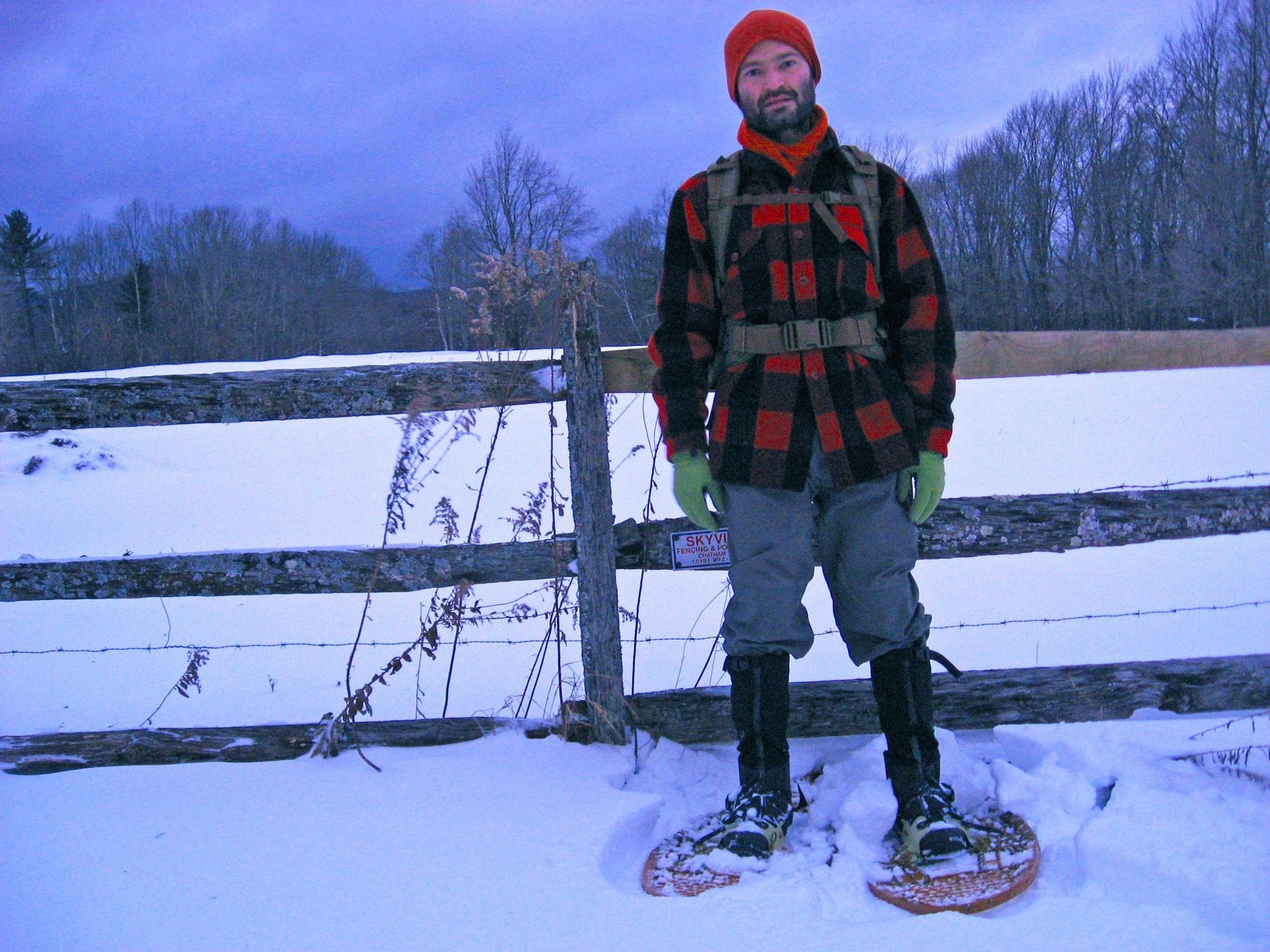

Leave a Comment